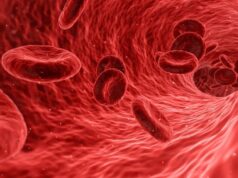
Five-year data from the NOBLE trial have confirmed its earlier findings that in patients with unprotected left main coronary disease the risk of major adverse cardiac or cerebrovascular events (MACCE) is higher with percutaneous coronary intervention (PCI) than with coronary artery bypass graft (CABG); the mortality risk was similar for both procedures. Published in the Lancet, the findings come in the wake of an ongoing controversy surrounding the interpretation of data from EXCEL, which found that PCI was non-inferior to CABG in left main disease at five years.
Writing in the Lancet, investigators Niels Holm (Aarhus University Hospital, Denmark) et al say: “In revascularisation of left main coronary artery disease, PCI was associated with an inferior clinical outcome at five years compared with CABG. Mortality was similar after the two procedures, but patients treated with PCI had higher rates of non-procedural myocardial infarction and repeat revascularisation.”
Analysing the findings for Cardiovascular News, David Hildick-Smith (Brighton and Sussex University Hospitals NHS Trust, Brighton, UK) said that the two trials are not incompatible: “People keep saying that the results of NOBLE and EXCEL are contradictory but they are, in fact, entirely consistent with each other. Broadly speaking, revascularisation is more common after PCI, but mortality is equivalent, particularly cardiovascular mortality. The endpoints of the studies were different, hence the apparent divergence of their results.”
Adrian Banning (John Radcliffe Hospital, Oxford, UK) agreed. He told Cardiovascular News that, although the “headline results” implied that NOBLE favoured CABG and EXCEL suggested that both therapies may be the same, “personally, I think there are a lot of things in common between the findings in EXCEL and NOBLE”.
He said: “Within NOBLE, the outcomes in the less complex patients (those with low syntax score) are inferior to CABG and that’s unexplained in my mind, along with the slight excess of stroke in the PCI group. My view is that if you add NOBLE, EXCEL, COMBAT, SYNTAX, and SYNTAXES there is a very reassuring long-term message about the role of stents in the left main. Careful analysis of the patient and the angiogram almost always suggests the optimal treatment for an individual, and I don’t think there are many patients where equipoise occurs.”
Stephan Windecker (Bern University Hospital, Bern, Switzerland) described NOBLE as “another very important piece of evidence that requires careful review in the context of the totality of evidence”.
The NOBLE trial was a prospective, randomised, open-label, noninferiority trial performed at 36 hospitals in Denmark, Estonia, Finland, Germany, Latvia, Lithuania, Norway, Sweden, and the UK to evaluate whether PCI was non-inferior to CABG in the treatment of left main coronary artery disease. Patients requiring revascularisation were enrolled and randomly assigned 1:1 to receive either PCI or CABG. Preliminary outcomes at three years were reported in 2016.
The primary endpoint was MACCE, a composite of all-cause mortality, non-procedural myocardial infarction, repeat revascularisation, and stroke. Non-inferiority of PCI to CABG was defined as the upper limit of the 95% confidence interval (CI) of the hazard ratio (HR) not exceeding 1.35 after 275 MACCE had occurred. Secondary endpoints included all-cause mortality, non-procedural myocardial infarction, and repeat revascularisation. Outcomes were analysed in the intention-to-treat population.
In all, 1,201 patients were enrolled between December 2008 and January 2015; 598 were allocated to PCI and 603 to CABG, of whom 17 were subsequently lost to early follow-up, leaving 592 patients for analysis in each group. At a median of 4.9 years of follow-up, the predefined number of events was reached for adequate power to assess the primary endpoint.
Median age of participants was 66.2 years (interquartile range [IQR] 9.9) in the PCI group and 66.2 (IQR 9.4) years in the CABG group; 116 (20%) patients in the PCI group and 140 (24%) in the CABG group were women; and 94 (16%) patients in the PCI group vs. 90 (15%) in the CABG group had diabetes. The clinical indication for revascularisation was stable angina pectoris in 486 (82%) of patients in the PCI group and 491 (83%) in the CABG group.
Kaplan-Meier five-year estimates of MACCE were 28% (165 events) for PCI and 19% (110 events) for CABG (HR 1.58, 95% CI 1.24–2.01); the HR exceeded the limit for non-inferiority of PCI compared to CABG. CABG was found to be superior to PCI for the primary composite endpoint (p=0.0002). All-cause mortality was estimated in 9% after PCI vs. 9% after CABG (HR 1.08, 95% CI 0.74–1.59, p=0.68); non-procedural myocardial infarction was estimated in 8% after PCI vs. 3% after CABG (HR 2.99, 95% CI 1.66–5.39, p=0.0002); and repeat revascularisation was estimated in 17% after PCI vs. 10% after CABG (HR 1.73, 95% CI 1.25–2.40, p=0·0009).
The authors advise that the results should be “generalised with caution”, pointing out: “Participating centres were selected on the basis of their interest in PCI of the left main coronary artery. The enrolment period was long, and the enrolled patients do not necessarily reflect the general population of patients with left main coronary artery disease. Clinically unstable patients were not enrolled.” They add: “The primary endpoint was evaluated after five years of follow-up instead of after two years because of lower than anticipated event rates.”
Last month, the European Association of Cardio-Thoracic Surgeons (EACTS) withdrew its support for the left main recommendations of the society’s joint guidelines with the European Society of Cardiology (ESC) on myocardial revascularisation following an investigation by the BBC current affairs programme Newsnight that cast doubt upon the conclusions drawn by EXCEL trial investigators. The investigators have refuted the claims.
Comparing NOBLE and EXCEL, Holm and colleagues note: “The recent five-year report of EXCEL showed that mortality after PCI was 13% in EXCEL versus 9% in NOBLE, a difference that might be at least in part explained by the higher proportion of patients with diabetes in EXCEL compared with in NOBLE. The differences in outcomes in the early reports were probably better explained by differences in primary and secondary endpoint definitions and the reported follow-up time than by differences in the quality of PCI. The primary composite endpoint in NOBLE, in contrast to EXCEL, included any repeat revascularisation, whereas periprocedural myocardial infarction was not included in the definition of myocardial infarction. A quarter of repeat revascularisations in the PCI group were performed as CABG in both the EXCEL and NOBLE trials, and a patient’s possible later need for CABG should not be underrated.”
And in relation to the guidelines, the researchers state: “Although the primary endpoint and increased rates of myocardial infarction and repeat revascularisation in NOBLE do not support the current clinical guidelines, the similar mortality of PCI and CABG, the general higher risk of stroke (except in NOBLE), longer hospitalisation, and risk of reoperation after CABG might still justify offering PCI to patients who are eligible for both treatment options. A thorough heart team evaluation will be required, with assessment of suitability for stenting or grafting and the overall surgical risk, and an individualised discussion with the patient on the benefits and risks associated with the two treatments to ensure they are able to provide sufficiently informed consent.”
Holm et al stress that, because NOBLE reached its predefined total number of required events, “reliable conclusions” can be drawn from the trial, and they suggest: “Revascularisation of patients with left main coronary artery disease and a limited number of additional stenoses can be performed with similar mortality by PCI or CABG, if deemed suitable for either treatment by a heart team. The presence of multivessel disease, particularly in combination with diabetes, should favour CABG because of an association with lower mortality, whereas PCI might be favoured in patients with acute coronary syndrome. Improved outcomes after PCI need to be achieved through tailored patient selection and optimised PCI.”













